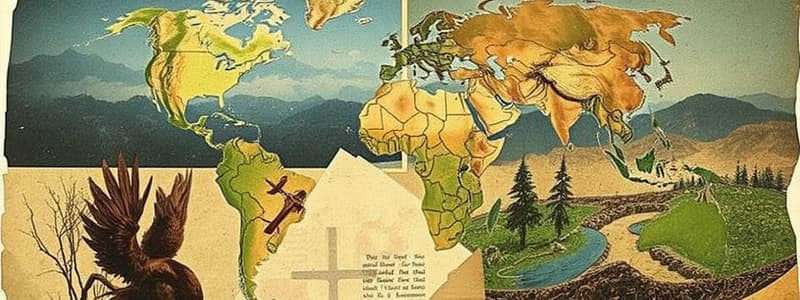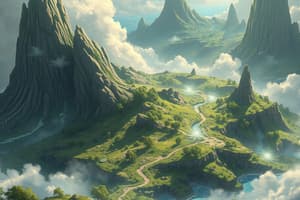Podcast
Questions and Answers
What is climate primarily defined by?
What is climate primarily defined by?
- The statistical summary of atmospheric pressure only
- The momentary state of temperature and rainfall
- The average weather conditions over a long period of time (correct)
- The average weather conditions on a specific day
Which of the following abiotic factors influences the nature of a biome?
Which of the following abiotic factors influences the nature of a biome?
- Plant diversity
- Humidity (correct)
- Type of soil
- Presence of animals
How do two different biomes, like a desert and a rainforest, compare in terms of vegetation?
How do two different biomes, like a desert and a rainforest, compare in terms of vegetation?
- The rainforest has fewer trees than the desert
- Both biomes have vast amounts of visible plants
- The desert has less plant density than the rainforest (correct)
- Both biomes have similar types of vegetation
What is the primary reason for temperature variations across different latitudes?
What is the primary reason for temperature variations across different latitudes?
Which two major climate zones are mentioned?
Which two major climate zones are mentioned?
What distinguishes terrestrial biomes from one another?
What distinguishes terrestrial biomes from one another?
How does climate typically differ from weather?
How does climate typically differ from weather?
Which biome is characterized by low rainfall and sparse vegetation?
Which biome is characterized by low rainfall and sparse vegetation?
Which factor does NOT influence local climate conditions?
Which factor does NOT influence local climate conditions?
The Sahara Desert and the Australian rainforest are examples of which of the following?
The Sahara Desert and the Australian rainforest are examples of which of the following?
How does temperature affect precipitation in different climates?
How does temperature affect precipitation in different climates?
What main factor determines the growing season for plants?
What main factor determines the growing season for plants?
What is a primary reason for the existence of a rain shadow effect?
What is a primary reason for the existence of a rain shadow effect?
What adaptations might desert plants have to survive in arid climates?
What adaptations might desert plants have to survive in arid climates?
Which climate is most likely to have the best soil for plant growth?
Which climate is most likely to have the best soil for plant growth?
Why do some organisms exhibit adaptations to cold climates?
Why do some organisms exhibit adaptations to cold climates?
How does climate affect biodiversity in terrestrial biomes?
How does climate affect biodiversity in terrestrial biomes?
What contributes to the amount of moisture in an area?
What contributes to the amount of moisture in an area?
What characteristic of tropical areas leads to higher rainfall compared to other regions?
What characteristic of tropical areas leads to higher rainfall compared to other regions?
Which of these is NOT a basic need for plant growth?
Which of these is NOT a basic need for plant growth?
What are terrestrial biomes primarily distinguished by?
What are terrestrial biomes primarily distinguished by?
Which factor can influence temperature in addition to latitude?
Which factor can influence temperature in addition to latitude?
What characterizes the climate of tropical regions?
What characterizes the climate of tropical regions?
What aspect of climate can vary significantly at different latitudes?
What aspect of climate can vary significantly at different latitudes?
Which of the following accurately describes weather?
Which of the following accurately describes weather?
Which biome is characterized by a lack of moisture and high temperatures?
Which biome is characterized by a lack of moisture and high temperatures?
What does the term 'abiotic factors' refer to in the context of biomes?
What does the term 'abiotic factors' refer to in the context of biomes?
In which biome would you expect to find the most biodiversity?
In which biome would you expect to find the most biodiversity?
Which of the following is NOT a characteristic of the tundra biome?
Which of the following is NOT a characteristic of the tundra biome?
What is the primary reason for the existence of various climate zones on Earth?
What is the primary reason for the existence of various climate zones on Earth?
What role does warm air play in relation to moisture?
What role does warm air play in relation to moisture?
Why do some mountain tops in tropical zones remain capped with snow?
Why do some mountain tops in tropical zones remain capped with snow?
What is a consequence of air rising over a mountain range?
What is a consequence of air rising over a mountain range?
Which statement about soil quality and climate is accurate?
Which statement about soil quality and climate is accurate?
How does biodiversity change with latitude?
How does biodiversity change with latitude?
What is a primary feature of organisms in arid climates?
What is a primary feature of organisms in arid climates?
What is the primary reason for the phenomenon known as a rain shadow?
What is the primary reason for the phenomenon known as a rain shadow?
Which of the following best describes the process of decomposition in relation to climate?
Which of the following best describes the process of decomposition in relation to climate?
How do cold climates affect plant dormancy?
How do cold climates affect plant dormancy?
Which adaptation do polar bears have for survival in Arctic climates?
Which adaptation do polar bears have for survival in Arctic climates?
Flashcards are hidden until you start studying
Study Notes
Climate and Biomes
- Climate refers to long-term averages of weather conditions including temperature, humidity, and precipitation, crucial for understanding ecosystems.
- Abiotic factors like temperature, wind, and rain significantly influence the characteristics of biomes, such as desert and rainforest formations.
Terrestrial Biomes
- A biome is a collection of similar ecosystems defined by shared abiotic factors and primary producers.
- Major terrestrial biomes include tundras, temperate forests, grasslands, chaparral, temperate and tropical deserts, and tropical forests.
Climate Characteristics
- Climate is defined as the average weather over time, while weather focuses on short-term conditions.
- Temperature gradients exist from the equator (hot) to the poles (cold), categorized into tropical, temperate, and arctic zones.
- Coastal regions experience moderate temperatures due to water's slow heat absorption and release, contrasting with inland areas.
Moisture and Precipitation
- Climates are classified based on moisture levels: arid (dry), semi-arid, humid (wet), and semi-humid.
- Factors affecting precipitation include air mass movement, temperature (warm air holds more moisture), and geographical features like mountains.
- Rain shadows occur when moist air rises over mountains, cools, and loses moisture, leading to dry conditions on the leeward side.
Plant Growth and Climate
- Plants, the primary producers in biomes, require air, warmth, sunlight, water, and nutrients, all influenced by climate.
- The growing season varies from year-round in tropical climates to just a few months in colder or drier regions.
- Soils rich in nutrients are ideal for plant growth, but decomposition rates differ across climates, affecting soil quality.
Biodiversity
- Biodiversity tends to increase from polar to equatorial regions and is generally higher in humid climates.
- The disparity between desert and rainforest biomes exemplifies how climate impacts the diversity of life forms within terrestrial biomes.
Organism Adaptations
- Species evolve specialized adaptations for survival in their respective climates; desert plants may store water, while cold-climate species might undergo dormancy.
- Examples of adaptations include:
- Aloe and cactus storing water in specialized tissues.
- Gila monsters storing water in their fat tails.
- Kangaroo rats with efficient kidneys to minimize water loss.
- Polar bears using thick fur and blubber for insulation against cold.
Summary of Climate Influence
- The climate determines key ecological aspects like plant growth, biodiversity, and organism adaptations in terrestrial biomes, illustrating the interconnectedness of environmental factors and living organisms.
Climate and Biomes
- Climate refers to long-term averages of weather conditions including temperature, humidity, and precipitation, crucial for understanding ecosystems.
- Abiotic factors like temperature, wind, and rain significantly influence the characteristics of biomes, such as desert and rainforest formations.
Terrestrial Biomes
- A biome is a collection of similar ecosystems defined by shared abiotic factors and primary producers.
- Major terrestrial biomes include tundras, temperate forests, grasslands, chaparral, temperate and tropical deserts, and tropical forests.
Climate Characteristics
- Climate is defined as the average weather over time, while weather focuses on short-term conditions.
- Temperature gradients exist from the equator (hot) to the poles (cold), categorized into tropical, temperate, and arctic zones.
- Coastal regions experience moderate temperatures due to water's slow heat absorption and release, contrasting with inland areas.
Moisture and Precipitation
- Climates are classified based on moisture levels: arid (dry), semi-arid, humid (wet), and semi-humid.
- Factors affecting precipitation include air mass movement, temperature (warm air holds more moisture), and geographical features like mountains.
- Rain shadows occur when moist air rises over mountains, cools, and loses moisture, leading to dry conditions on the leeward side.
Plant Growth and Climate
- Plants, the primary producers in biomes, require air, warmth, sunlight, water, and nutrients, all influenced by climate.
- The growing season varies from year-round in tropical climates to just a few months in colder or drier regions.
- Soils rich in nutrients are ideal for plant growth, but decomposition rates differ across climates, affecting soil quality.
Biodiversity
- Biodiversity tends to increase from polar to equatorial regions and is generally higher in humid climates.
- The disparity between desert and rainforest biomes exemplifies how climate impacts the diversity of life forms within terrestrial biomes.
Organism Adaptations
- Species evolve specialized adaptations for survival in their respective climates; desert plants may store water, while cold-climate species might undergo dormancy.
- Examples of adaptations include:
- Aloe and cactus storing water in specialized tissues.
- Gila monsters storing water in their fat tails.
- Kangaroo rats with efficient kidneys to minimize water loss.
- Polar bears using thick fur and blubber for insulation against cold.
Summary of Climate Influence
- The climate determines key ecological aspects like plant growth, biodiversity, and organism adaptations in terrestrial biomes, illustrating the interconnectedness of environmental factors and living organisms.
Studying That Suits You
Use AI to generate personalized quizzes and flashcards to suit your learning preferences.




